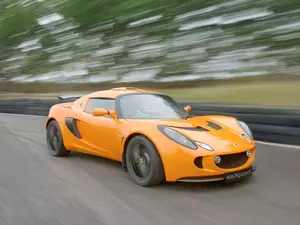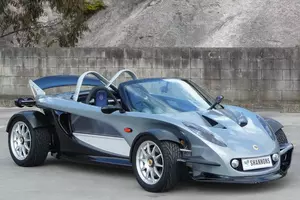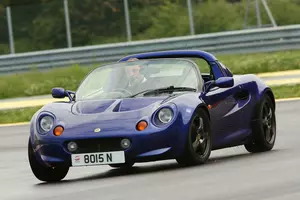
| Vehicle | Precise engine size | Difference from world average | Engine size to consumption ratio | Horsepower from 1 L | Engine size to 100 kg of weight |
|---|---|---|---|---|---|
| Cup 250 1.8 |
1.8 L (1798 cc) |
23.4% smaller | 58 cc to 1 mpg | 137 hp from 1 L | 200 cc to 100 kg |
| Cup 260 1.8 |
1.8 L (1798 cc) |
23.4% smaller | 58 cc to 1 mpg | 141 hp from 1 L | 200 cc to 100 kg |
| Vehicle | Cup 250 1.8 |
|---|---|
| Precise engine size | 1.8 L (1798 cc) |
| Difference from world average | 23.4 smaller |
| Engine size to consumption ratio | 58 cc to 1 mpg |
| Horsepower from 1 L | 137 hp from 1 L |
| Engine size to 100 kg of weight | 200 cc to 100 kg |
| Vehicle | Cup 260 1.8 |
| Precise engine size | 1.8 L (1798 cc) |
| Difference from world average | 23.4 smaller |
| Engine size to consumption ratio | 58 cc to 1 mpg |
| Horsepower from 1 L | 141 hp from 1 L |
| Engine size to 100 kg of weight | 200 cc to 100 kg |

| Vehicle | Precise engine size | Difference from world average | Engine size to consumption ratio | Horsepower from 1 L | Engine size to 100 kg of weight |
|---|---|---|---|---|---|
| Cup 250 1.8 |
1.8 L (1798 cc) |
23.4% smaller | 58 cc to 1 mpg | 137 hp from 1 L | 200 cc to 100 kg |
| Sport 1.6 |
1.6 L (1598 cc) |
31.9% smaller | 43 cc to 1 mpg | 85 hp from 1 L | 178 cc to 100 kg |
| Sport 220 1.8 |
1.8 L (1798 cc) |
23.4% smaller | 58 cc to 1 mpg | 122 hp from 1 L | 200 cc to 100 kg |
| Vehicle | Cup 250 1.8 |
|---|---|
| Precise engine size | 1.8 L (1798 cc) |
| Difference from world average | 23.4 smaller |
| Engine size to consumption ratio | 58 cc to 1 mpg |
| Horsepower from 1 L | 137 hp from 1 L |
| Engine size to 100 kg of weight | 200 cc to 100 kg |
| Vehicle | Sport 1.6 |
| Precise engine size | 1.6 L (1598 cc) |
| Difference from world average | 31.9 smaller |
| Engine size to consumption ratio | 43 cc to 1 mpg |
| Horsepower from 1 L | 85 hp from 1 L |
| Engine size to 100 kg of weight | 178 cc to 100 kg |
| Vehicle | Sport 220 1.8 |
| Precise engine size | 1.8 L (1798 cc) |
| Difference from world average | 23.4 smaller |
| Engine size to consumption ratio | 58 cc to 1 mpg |
| Horsepower from 1 L | 122 hp from 1 L |
| Engine size to 100 kg of weight | 200 cc to 100 kg |

| Vehicle | Precise engine size | Difference from world average | Engine size to consumption ratio | Horsepower from 1 L | Engine size to 100 kg of weight |
|---|---|---|---|---|---|
| 1.8 i 16V |
1.8 L (1795 cc) |
23.5% smaller | 56 cc to 1 mpg | 68 hp from 1 L | 224 cc to 100 kg |
| 1.8 i 16V 111 |
1.8 L (1795 cc) |
23.5% smaller | 53 cc to 1 mpg | 89 hp from 1 L | 224 cc to 100 kg |
| 1.8 i 16V 111R |
1.8 L (1796 cc) |
23.4% smaller | - | 107 hp from 1 L | 200 cc to 100 kg |
| Vehicle | 1.8 i 16V |
|---|---|
| Precise engine size | 1.8 L (1795 cc) |
| Difference from world average | 23.5 smaller |
| Engine size to consumption ratio | 56 cc to 1 mpg |
| Horsepower from 1 L | 68 hp from 1 L |
| Engine size to 100 kg of weight | 224 cc to 100 kg |
| Vehicle | 1.8 i 16V 111 |
| Precise engine size | 1.8 L (1795 cc) |
| Difference from world average | 23.5 smaller |
| Engine size to consumption ratio | 53 cc to 1 mpg |
| Horsepower from 1 L | 89 hp from 1 L |
| Engine size to 100 kg of weight | 224 cc to 100 kg |
| Vehicle | 1.8 i 16V 111R |
| Precise engine size | 1.8 L (1796 cc) |
| Difference from world average | 23.4 smaller |
| Engine size to consumption ratio | - |
| Horsepower from 1 L | 107 hp from 1 L |
| Engine size to 100 kg of weight | 200 cc to 100 kg |

| Vehicle | Precise engine size | Difference from world average | Engine size to consumption ratio | Horsepower from 1 L | Engine size to 100 kg of weight |
|---|---|---|---|---|---|
| 1.8 i 16V |
1.8 L (1796 cc) |
23.4% smaller | - | 100 hp from 1 L | 257 cc to 100 kg |
| Vehicle | 1.8 i 16V |
|---|---|
| Precise engine size | 1.8 L (1796 cc) |
| Difference from world average | 23.4 smaller |
| Engine size to consumption ratio | - |
| Horsepower from 1 L | 100 hp from 1 L |
| Engine size to 100 kg of weight | 257 cc to 100 kg |

| Vehicle | Precise engine size | Difference from world average | Engine size to consumption ratio | Horsepower from 1 L | Engine size to 100 kg of weight |
|---|---|---|---|---|---|
| 1.8 i 16V |
1.8 L (1796 cc) |
23.4% smaller | - | 67 hp from 1 L | 257 cc to 100 kg |
| 1.8 i 16V 111S |
1.8 L (1796 cc) |
23.4% smaller | - | 81 hp from 1 L | 225 cc to 100 kg |
| Vehicle | 1.8 i 16V |
|---|---|
| Precise engine size | 1.8 L (1796 cc) |
| Difference from world average | 23.4 smaller |
| Engine size to consumption ratio | - |
| Horsepower from 1 L | 67 hp from 1 L |
| Engine size to 100 kg of weight | 257 cc to 100 kg |
| Vehicle | 1.8 i 16V 111S |
| Precise engine size | 1.8 L (1796 cc) |
| Difference from world average | 23.4 smaller |
| Engine size to consumption ratio | - |
| Horsepower from 1 L | 81 hp from 1 L |
| Engine size to 100 kg of weight | 225 cc to 100 kg |